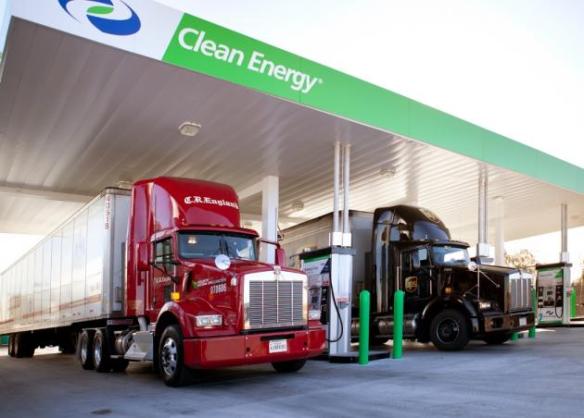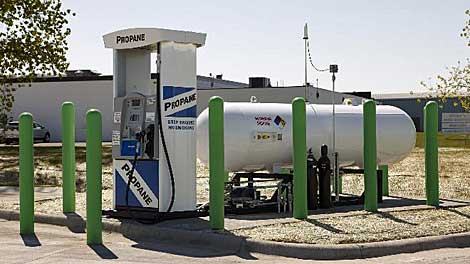
GE (GE) and Peake Fuel Solutions, an affiliate of Chesapeake Energy Corporation (CHK), today launched the CNG In A Box™ system, which allows easier adoption of compressed natural gas (CNG) refueling options for large- and small-scale retailers. The solution was unveiled at the National Association of Convenience Stores (NACS) 2012 Annual Show.
Natural gas is an abundant, reliable and cleaner-burning source of energy for consumers and commercial users. A vehicle fleet operator that uses the CNG In A Box system for natural gas fueling instead of traditional gasoline fueling can save about 40 percent in fuel costs1. The CNG In A Box system is a plug-and-play on-site fueling solution that comes with everything retailers need to add low-cost natural gas fuel to their operations quickly and simply. This GE ecomagination™ qualified refueling option provides an easy, lower-cost fueling experience for consumers and a higher-margin solution for facility operators compared to gasoline or diesel.
“In collaboration with Peake Fuel Solutions, GE is developing infrastructure solutions to accelerate the adoption of natural gas as a transportation fuel,” said Mike Hosford, general manager—Unconventional Resources, GE Oil & Gas. “The CNG In A Box system is a unique fueling solution that brings together some of the best innovation from across GE to help fleet owners and everyday drivers realize the benefits of cleaner burning, abundant, more affordable natural gas.”
“After working extensively with GE to develop the CNG In A Box system, we are excited to unveil it at NACS and to the fueling industry overall. Combining Peake Fuel Solutions’ natural gas expertise and GE’s breadth of cross-industry technology capabilities will advance the use of abundant and affordable natural gas fueling solutions,” said Kent Wilkinson, vice president—Natural Gas Ventures, Chesapeake.
The CNG In A Box system compresses natural gas from a pipeline into CNG on-site at a traditional automotive fueling station or industrial location. CNG-powered vehicles such as taxis, buses or small trucks, as well as individual consumer vehicles, can then refill their tanks using a dispenser with the same look and feel as a traditional diesel or gasoline dispenser.
GE ecomagination Vice President Mark Vachon said, “Natural gas is produced at a relatively lower cost and is cleaner burning than gasoline or diesel fuel—natural gas vehicles can show an emissions reduction of up to 80 percent compared to gasoline vehicles2. Through ecomagination, we’ll continue to deliver to the industry innovative solutions that deliver both great economics and environmental performance, and the CNG In A Box system exemplifies this commitment.”
Financing for the CNG In A Box system is offered by GE Capital, providing competitive rates and flexible payment options. By combining an entire acquisition—including equipment, delivery and installation—into a single monthly payment, Peake Fuel Solutions’ customers can structure payments according to their cash flow and eliminate the costs and time associated with paying multiple vendors. With this solution, business owners can work with a single provider to acquire, finance and maintain their CNG In A Box system.
The CNG In A Box system’s 8 foot x 20 foot container is easy to ship and maintain due to its compact design. Its modular and novel design makes it plug-and-play on-site. Wayne, A GE Energy Business, manufactures the dispensers that deliver the CNG from the CNG In A Box system unit to vehicles. These alternative fuel dispensers feature PCI-compliant pay-at-the-pump technology for a familiar and secure fueling experience. Using the same dispenser and payment terminal interfaces as Wayne petroleum dispensers simplifies point of sale integration.
As part of this collaboration between GE and Peake Fuel Solutions, beginning in the fall of 2012 GE will provide more than 250 CNG In A Box systems for natural gas vehicle infrastructure.
To learn more about the CNG In A Box system, visit us online or stop by the Peake Fuel Solutions booth at the NACS show (booth #6101).
Ecomagination is GE’s commitment to imagine and build innovative solutions to today’s environmental challenges while driving economic growth. For more on ecomagination, please visit:www.ecomagination.com.
About GE
GE (GE) works on things that matter. The best people and the best technologies taking on the toughest challenges. Finding solutions in energy, health and home, transportation and finance. Building, powering, moving and curing the world. Not just imagining. Doing. GE works. For more information, visit the company’s website at www.ge.com.
About Chesapeake Energy Corporation
Chesapeake Energy Corporation (CHK) is the second-largest producer of natural gas, a Top 15 producer of oil and natural gas liquids and the most active driller of new wells in the U.S. Headquartered in Oklahoma City, the company’s operations are focused on discovering and developing unconventional natural gas and oil fields onshore in the U.S. Chesapeake owns leading positions in the Eagle Ford, Utica, Granite Wash, Cleveland, Tonkawa, Mississippi Lime and Niobrara unconventional liquids plays and in the Marcellus, Haynesville/Bossier and Barnett unconventional natural gas shale plays. The company also owns substantial marketing and oilfield services businesses through its subsidiaries Chesapeake Energy Marketing, Inc. and Chesapeake Oilfield Services, L.L.C. Further information is available at www.chk.com where Chesapeake routinely posts announcements, updates, events, investor information, presentations and news releases.
About Peake Fuel Solutions
Peake Fuel Solutions advances innovative fuel solutions with products and services that create demand for clean, affordable natural gas. A significant focus of PFS is to increase compressed natural gas (CNG) and liquefied natural gas (LNG) infrastructure across the U.S. Other PFS projects include development of on-road and off-road technologies that reduce emissions and dramatically cut fuel expenses for the trucking, maritime, rail and oil and gas industries. An affiliate of Chesapeake Energy Corporation, Peake leverages the expertise of other Chesapeake affiliates to implement many of its fuel solutions. Further information is available at www.peakefuelsolutions.com.
1 Assuming 25,700 miles per year driven, gasoline priced at $3.50/gallon and CNG at $2.09/gasoline gallon equivalent.
2 Calfornia Energy Commission – Consumer Education Center:http://www.consumerenergycenter.org/transportation/afvs/cng.html
ecomagination is a trademark of the General Electric Company
CNG In A Box is a trademark of the General Electric Company
© 2012 General Electric Company—All rights reserved
Photos/Multimedia Gallery Available: http://www.businesswire.com/cgi-bin/mmg.cgi?eid=50433209&lang=en
MULTIMEDIA AVAILABLE:http://www.businesswire.com/cgi-bin/mmg.cgi?eid=50433209&lang=en
SOURCE- CNGNOW.com










